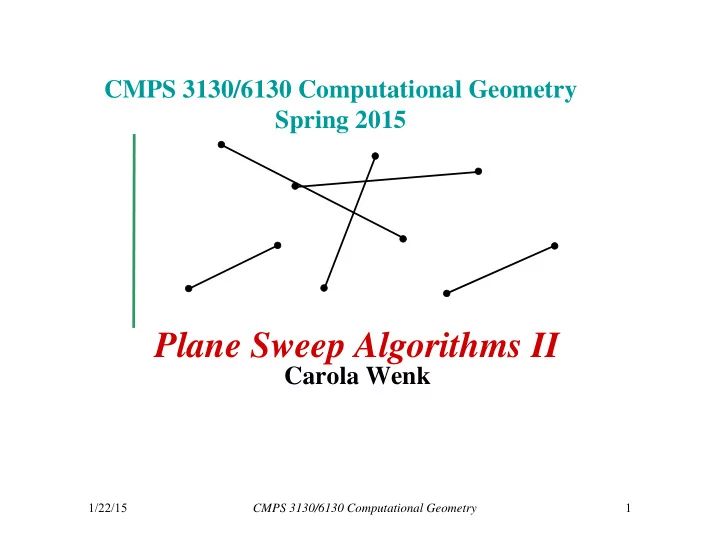

CMPS 3130/6130 Computational Geometry Spring 2015 Plane Sweep Algorithms II Carola Wenk 1/22/15 1 CMPS 3130/6130 Computational Geometry
Geometric Intersections • Important and basic problem in Computational Geometry • Solid modeling: Build shapes by applying set operations (intersection, union). • Robotics: Collision detection and avoidance • Geographic information systems: Overlay two subdivisions (e.g., road network and river network) • Computer graphics: Ray shooting to render scenes 1/22/15 2 CMPS 3130/6130 Computational Geometry
Line Segment Intersection • Input: A set S ={ s 1 , …, s n } of (closed) line segments in R 2 • Output: All intersection points between segments in S 1/22/15 3 CMPS 3130/6130 Computational Geometry
Line Segment Intersection • n line segments can intersect as few as 0 and as many as n =O( n 2 ) times 2 • Simple algorithm: Try out all pairs of line segments → Takes O( n 2 ) time → Is optimal in worst case • Challenge: Develop an output-sensitive algorithm – Runtime depends on size k of the output – Here: 0 k c n 2 , where c is a constant – Our algorithm will have runtime: O( ( n+k ) log n ) – Best possible runtime: O( n log n + k ) → O( n 2 ) in worst case, but better in general 1/22/15 4 CMPS 3130/6130 Computational Geometry
Complexity • Why is runtime O( n log n + k ) optimal? • The element uniqueness problem requires ( n log n ) time in algebraic decision tree model of computation (Ben-Or ’83) • Element uniqueness : Given n real numbers, are all of them distinct? • Solve element uniqueness using line segment intersection : – Take n numbers, convert into vertical line segments. There is an intersection iff there are duplicate numbers. – If we could solve line segment intersection in o( n log n ) time, i.e., strictly faster than Θ ( n log n ), then element uniqueness could be solved faster. Contradiction. 1/22/15 5 CMPS 3130/6130 Computational Geometry
Plane sweep algorithm • Cleanliness property: – All intersections to the left of sweep line l have been reported • Sweep line status: – Store segments that intersect the sweep line l , ordered along the intersection with l . • Events: – Points in time when sweep line status changes combinatorially (i.e., the order of segments intersecting l changes) → Endpoints of segments (insert in beginning) → Intersection points (compute on the fly during plane sweep) 1/22/15 6 CMPS 3130/6130 Computational Geometry
General position Assume that “nasty” special cases don’t happen: – No line segment is vertical – Two segments intersect in at most one point – No three segments intersect in a common point 1/22/15 7 CMPS 3130/6130 Computational Geometry
Event Queue • Need to keep events sorted: – Lexicographic order (first by x -coordinate, and if two events have same x -coordinate then by y -coordinate) • Need to be able to remove next point, and insert new points in O(log n ) time • Need to make sure not to process same event twice Use a priority queue (heap), and possibly extract multiples Or, use balanced binary search tree 1/22/15 8 CMPS 3130/6130 Computational Geometry
Sweep Line Status • Store segments that intersect the sweep line l , ordered along the intersection with l . • Need to insert, delete, and find adjacent neighbor in O(log n ) time • Use balanced binary search tree, storing the order in which segments intersect l in leaves b c e d c b e d 1/22/15 9 CMPS 3130/6130 Computational Geometry
Event Handling 1. Left segment endpoint – Add new segment to sweep line status – Test adjacent segments on sweep line l for intersection with new segment (see Lemma) – Add new intersection points to event queue b c a e d c c b b d e d 1/22/15 10 CMPS 3130/6130 Computational Geometry
Event Handling 2. Intersection point – Report new intersection point – Two segments change order along l → Test new adjacent segments for new intersection points (to insert into event queue) b c a e d Note: “new” intersection c c might have been already b e e b detected earlier. d d 1/22/15 11 CMPS 3130/6130 Computational Geometry
Event Handling 3. Right segment endpoint – Delete segment from sweep line status – Two segments become adjacent . Check for intersection points (to insert in event queue) b c a e d e e c c b d d 1/22/15 12 CMPS 3130/6130 Computational Geometry
Intersection Lemma • Lemma: Let s , s’ be two non-vertical segments whose interiors intersect in a single point p . Assume there is no third segment passing through p . Then there is an event point to the left of p where s and s’ become adjacent (and hence are tested for intersection). • Proof: Consider placement of sweep line infinitesimally left of p . s and s’ are adjacent along sweep line. Hence there must have been a previous event point where s and s’ become adjacent. s’ p s 1/22/15 13 CMPS 3130/6130 Computational Geometry
Runtime • Sweep line status updates: O(log n ) • Event queue operations: O(log n ), as the total number of stored events is 2 n + k , and each operation takes time O(log(2 n + k )) = O(log n 2 ) = O(log n ) k = O( n 2 ) • There are O( n + k ) events. Hence the total runtime is O(( n + k ) log n ) 1/22/15 14 CMPS 3130/6130 Computational Geometry
Recommend
More recommend